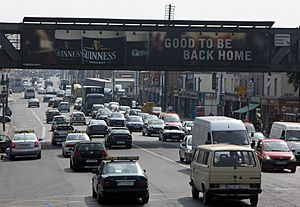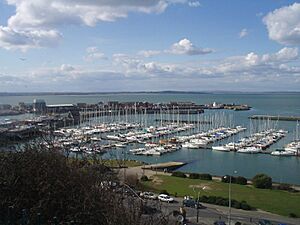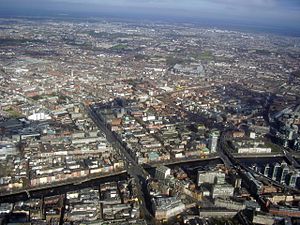Northside, Dublin facts for kids
Quick facts for kids
The Northside
|
|
|---|---|
|
Dublin, north of the Liffey
|
|

O'Connell Bridge, looking northeast
|
|
| Country | Ireland |
| County | County Dublin |
| City | Dublin |
The Northside (Irish: Taobh Ó Thuaidh) is a common name for the part of Dublin, Ireland, that is north of the River Liffey. It also includes some areas in North County Dublin. While some people think it's not as rich as the city's Southside, the Northside was actually where many wealthy families first lived. Today, places like Malahide, Howth, Clontarf, and Castleknock are some of the richest areas in Ireland, and they are all north of the river.
Contents
What is the Northside?
The Northside isn't an official area, so its exact borders can change depending on who you ask. It usually includes parts of Dublin city north of the River Liffey. It also often includes towns north of the M50 motorway, like Swords and Malahide. These towns have grown to become suburbs of Dublin city.
The Northside in Books and TV
Many stories and TV shows are set on the Northside.
Famous Writers and Their Stories
James Joyce, a famous writer, set some of his Dubliners stories on the Northside. This was because he spent time there as a child in areas like Drumcondra and Fairview.
More recently, writers like Dermot Bolger and Booker Prize winner Roddy Doyle have written a lot about the Northside. Roddy Doyle set many of his novels in a made-up Northside area called Barrytown.
TV Shows Set on the Northside
The popular Irish TV show Fair City takes place in Carrigstown. This is a made-up suburb within Dublin's Northside. According to the RTÉ Guide, Carrigstown is located near Drumcondra to the north, the city centre to the south, East Wall to the east, and Phibsboro to the west.
Areas of the Northside
The Northside includes the northern part of Dublin city centre. Some well-known streets here are noted below. It also has districts like Smithfield and Summerhill. Some older districts, like Oxmantown, don't exist anymore.
Beyond the city centre, the Northside has many other areas. Most of these names are very old, even though many were just small country areas until recently. Some are separate suburbs or villages, while others are parts of bigger areas.
- Artane
- Arbour Hill
- Ashtown
- Balbriggan
- Ballybough
- Ballyboughal
- Baldoyle
- Balgriffin
- Ballygall
- Ballymun
- Bayside
- Beaumont
- Blanchardstown
- Broadstone
- Cabra
- Castleknock
- Clonee
- Clongriffin
- Clonsilla
- Clontarf
- Coolock
- Corduff
- Darndale
- Dollymount
- Donabate
- Donaghmede
- Donnycarney
- Drumcondra
- East Wall
- Fairview
- Finglas
- Glasnevin
- Grangegorman
- Harmonstown
- Howth
- Kilbarrack
- Killester
- Kilmore
- Kinsealy
- Malahide
- Marino
- Mulhuddart
- North Wall
- North Strand
- Ongar
- Oxmantown
- Phibsboro
- Portmarnock
- Priorswood
- Raheny
- Santry
- Sheriff Street
- Skerries
- Smithfield
- Stoneybatter
- Strawberry Beds
- Sutton
- Summerhill
- Swords
- Tyrellstown
- Whitehall.
How the Northside is Governed
The Northside is managed by two local councils. Dublin City Council (which used to be called Dublin Corporation) looks after most of the area. Fingal County Council manages the rest, especially the parts outside the city centre.
Dublin Postal Codes
Dublin's postal codes have a special system. Traditionally, areas on the Northside have odd numbers, like Dublin 1 or Dublin 11. Areas on the Southside have even numbers.
For example, O'Connell Street is in Dublin 1. The suburb of Ballymun is in Dublin 11. There's one exception: Phoenix Park is on the Northside but is part of Dublin 8. This is because a sorting office on the Southside used to handle its mail.
In 2014, Ireland introduced a new postal code system called Eircode. For Dublin addresses, the old postal district numbers were used to create new prefixes. So, Dublin 1 became D01, and Dublin 11 became D11.
Some areas on the outer edges of the Northside, especially in Fingal, have Eircodes starting with 'K'. For example, Swords is K67, and Malahide is K36. The town of Clonee in County Meath, which is near Dublin, also has a Dublin Eircode: D15.
Here are some examples of addresses:
- The Gresham Hotel
- 23 Upper O'Connell Street
- Dublin 1
- D01 C3W7.
- Coffee Works
- 62 Main Street
- Swords
- County Dublin
- K67 RX94.
Famous Landmarks and Places
The Northside is home to many well-known places and sights:
- Abbey Street
- Abbey Theatre, Ireland's National Theatre
- Ambassador Theatre
- Áras an Uachtaráin, where the President lives
- Arbour Hill Prison
- Beaumont Hospital
- Blessington Street Basin
- Bull Island including Dollymount Strand
- Capel Street
- Casino at Marino
- Casino Model Railway Museum
- Castleknock Castle
- Clontarf Castle
- Croppies' Acre
- Connolly Station
- Croke Park
- The Custom House
- Dalymount Park
- Dorset Street
- Dublin City Gallery The Hugh Lane
- Dublin City University
- Dublin Port
- Dublin Zoo
- Dunsink Observatory
- EPIC The Irish Emigration Museum
- Farmleigh
- Four Courts
- Garden of Remembrance
- Gate Theatre
- General Post Office (GPO)
- Glasnevin Cemetery
- Grand Canal
- Grangegorman Military Cemetery
- Henrietta Street
- Henry Street
- Howth Castle
- Howth Head
- International Financial Services Centre
- Ireland's Eye
- Irish Writers Centre
- James Joyce Centre
- King's Inns
- Lambay Island
- Malahide Castle and regional park
- Mater Hospital
- Moore Street
- Morton Stadium
- Mountjoy Prison
- Mountjoy Square
- National Aquatic Centre
- National Botanic Gardens
- National Museum of Ireland (Collins Barracks)
- National Transport Museum of Ireland
- Newbridge Demesne
- North Circular Road
- O'Connell Street
- Old Jameson Whiskey Distillery
- Parnell Square
- Phoenix Park
- Rotunda Hospital
- Royal Canal
- Saint Anne's Park
- St. Brendan's Hospital, Dublin
- St Doulagh's Church
- St. Mary's Church
- St. Mary's Hospital (Phoenix Park)
- St Mary's Pro-Cathedral
- St. Michan's Church
- Smithfield
- Spire of Dublin
- Swords Castle
- Talbot Street
- The Helix
- Tolka Park
- Wellington Monument
- 3Arena
Transport, Shopping, and Education
Major transport hubs on the Northside include Connolly Station, Busáras (the main bus station for national routes), and Dublin Airport.
The busiest shopping street in Ireland, Henry Street/Mary Street, is in the north inner city, just off O'Connell Street. Three of Dublin's five city-centre shopping centres are on the Northside: the Jervis Shopping Centre, the Ilac Centre/Moore Street Mall, and the Irish Life Shopping Mall. There are also large shopping centres outside the city centre in Blanchardstown, Swords, Coolock, Charlestown (in Finglas), and Donaghmede.
The Cineworld cinema on Parnell Street is the largest in Ireland with seventeen screens. The Savoy on O'Connell Street is one of Ireland's oldest cinemas.
For higher education, the Northside has the Grangegorman Campus of Technological University Dublin, which is Dublin's newest university. Also, Dublin City University has its main campus in Glasnevin and Drumcondra.
Government and State Bodies
Several important Irish government offices and state bodies are located on the Northside. These include Met Éireann (Ireland's weather office), Enterprise Ireland (which helps Irish businesses), the National Standards Authority of Ireland, and the Sustainable Energy Authority of Ireland. Also, the Department of Defence, the Department of Education, and the Department of Housing, Local Government and Heritage have offices here.
See also
 In Spanish: Norte de Dublín para niños
In Spanish: Norte de Dublín para niños





